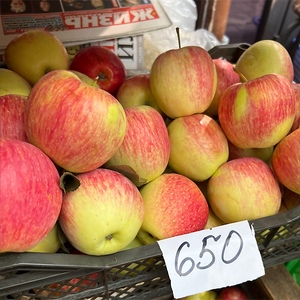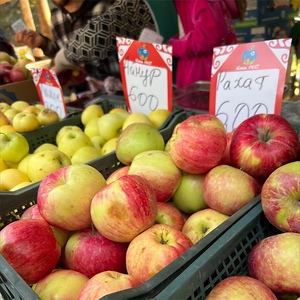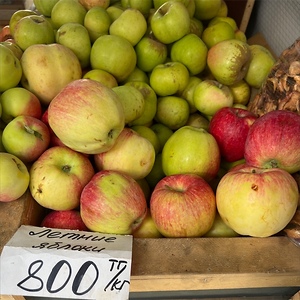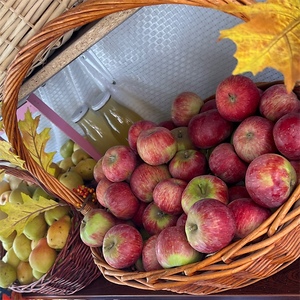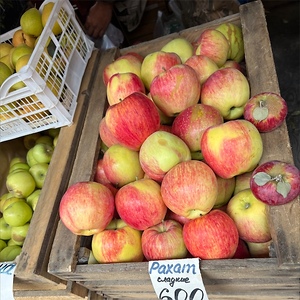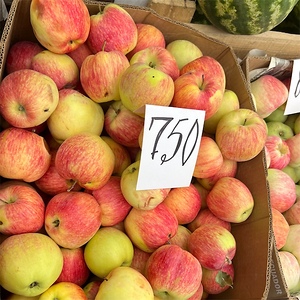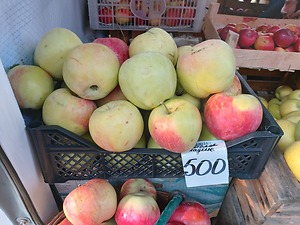

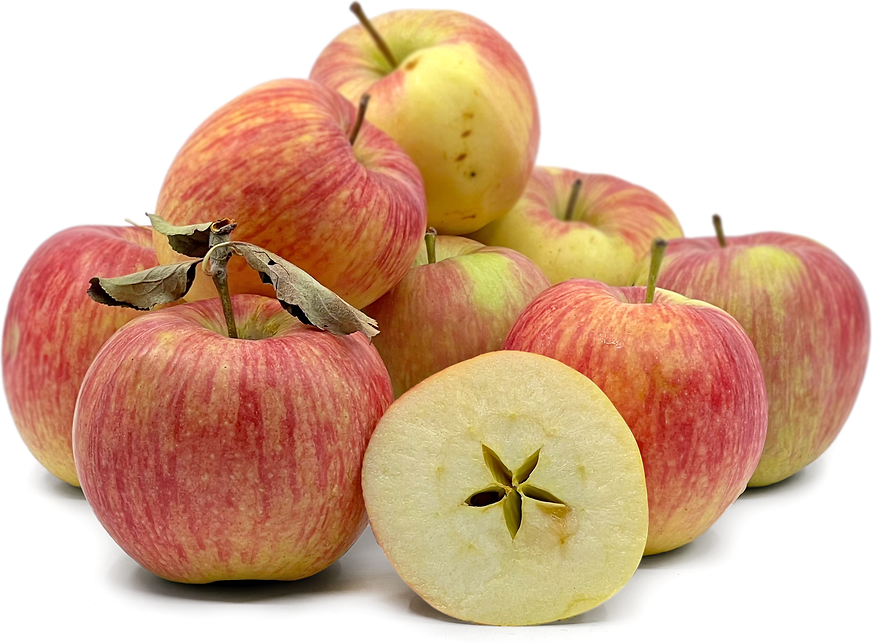
Rakhat Apples
Estimated Inventory, 1 Lb : 0
Description/Taste
Rakhat apples are small to medium fruits, averaging 9 to 10 centimeters in length, and have a uniform, ovate to conical shape. The skin is thin, semi-smooth, and waxy with a yellow-green base, covered in large patches of red blush and striping. Underneath the surface, the flesh is crisp, dense, ivory to pale yellow, aqueous, and subtly coarse, encasing a central core filled with oval, black-brown seeds. Rakhat apples are aromatic and have a sweet flavor balanced with pleasant, tart, and acidic notes.
Seasons/Availability
Rakhat apples are available in the fall through winter in Central Asia.
Current Facts
Rakhat apples, botanically classified as Malus domestica, are a Central Asian variety belonging to the Rosaceae family. The name Rakhat roughly translates to mean “pleasure” or “delight,” and the variety was given this descriptor in honor of the fruit’s sweet, aromatic flavor. Rakhat apples were developed in Kazakhstan as an improved cultivar of the ancient aport apple, one of the most famous apple varieties in the country. In the last decade, there has been a movement among Kazakh scientists to extensively study local varieties such as aport apples in order to create modern cultivars with superior genetics for industrial production. Rakhat apples were one of the successful varieties selected for commercial release, and in the modern-day, the apples are primarily localized to fresh markets in Kazakhstan, favored for fresh consumption.
Nutritional Value
Rakhat apples are an excellent source of vitamins A and C, antioxidants that strengthen the immune system, reduce inflammation, and protect the body against free radicals. The apples are also a good source of fiber to stimulate the digestive tract, potassium to balance fluid levels within the body, and provide lower amounts of vitamin K, vitamin B6, manganese, and phosphorus.
Applications
Rakhat apples are best suited for both fresh and cooked applications, including baking, roasting, and sautéing. The apples can be consumed straight, out-of-hand, chopped into fruit bowls, sliced into green salads, or quartered and served on appetizer plates with nuts, cheeses, and meats. Rakhat apples can also be pressed into juices, blended into smoothies, topped over oatmeal, or mixed into grain bowls. In addition to fresh preparations, Rakhat apples can be hollowed, filled with nuts, and baked as a dessert, chopped and incorporated into muffins and bread, sliced for cakes, pies, and tarts, baked into crumbles, or pureed and cooked into applesauce. The fruits can also be simmered into jams, jellies, and compotes or cooked into sauces for roasted meats. Rakhat apples pair well with spices such as cinnamon, nutmeg, allspice, and cloves, meats such as pork, beef, and poultry, vanilla, honey, lemon juice, dark leafy greens, nuts such as almonds, pistachios, and walnuts, and cheeses such as brie, mozzarella, and cheddar. Whole Rakhat apples will keep 2 to 3 months when stored in the crisper drawer of the refrigerator.
Ethnic/Cultural Info
Rakhat apples were planted at the Olzhas Suleimenov Alley in the fall of 2019. The newly constructed alley is a part of the Atakent Exhibition Center, a facility that hosts international exhibitions to promote business relations and trade in Kazakhstan. The center is also an environmentally conscious facility, which partially spurred the creation of the Olzhas Suleimenov Alley. Sixty apple trees were planted in the alley, and the three main apple varieties included Rakhat, voskhod, and glory to the winner. The alley was named after Olzhas Suleimenov, a famous Kazakh writer, poet, activist, and political figure. Suleimenov is well-known for his participation in one of the first Kazakh anti-nuclear movements known as the Nevada Semipalatinsk in 1989. In celebration of the movement, the alley was officially opened 30 years later on the anniversary of Nevada Semipalatinsk on September 26th, 2019. One unique feature of the alley is the engraved nameplates attached to each planted apple tree. The plate features the name of the famous public figure that planted the tree in the alley, and besides Olzhas Suleimenov, the trees were planted by ecologists, journalists, philosophers, and archaeologists.
Geography/History
Rakhat apples were developed at the Kazakh Research Institute of Fruit and Viticulture in Almaty, Kazakhstan. While the exact date of the variety’s release is unknown, Rakhat apples were bred from aport apples and other varieties, selected as a new cultivar for their improved storage quality, flavor, and appearance. The Kazakh Research Institute of Fruit and Viticulture has developed over 23 new varieties of apples, including Rakhat, that are being planted across the country for trial, research, and local consumption. Today Rakhat apples are primarily cultivated in Kazakhstan and are sold through fresh, local markets.
Recipe Ideas
Recipes that include Rakhat Apples. One



